Aftershaft Leech
By Philip Rowley
About 9 years ago I was fishing Whitetail Lake in southeastern
British Columbia. Whitetail Lake has a reputation for
large trout although its gin-clear waters and scenic
beauty are reason enough to visit. Leech patterns
were proving to be successful specially in the early
evening but I was not satisfied with their performance.
One evening I was fortunate to hook a good fish. Just
prior to releasing him, I pumped his stomach and found
he had been feeding on a number of 3-inch leeches.
Looking at the leeches in the palm of my hand, it was
clear how slender they were, about the diameter of a
pipe cleaner. Reviewing my own leech patterns confirmed
my suspicions, I needed a new slim life-like pattern.
The late Gene Armstrong from Kaufmann's Bellevue, Washington
location developed a number of successful lake patterns
using filoplume or aftershaft feathers as his primary
ingredient. Spurred on my Gene's designs I created my
own version of his Filoplume Leech. The next evening,
armed with a handful of these feather duster patterns,
I tried my luck. Using a dry line and a weighted pattern
to probe the shallows, my variation was an outstanding
success. A number of Whitetail Lake's larger inhabitants
towed me around the lake on that trip. I will always
remember their searing runs. The aftershaft made a
realistic body and, coupled with a long marabou tail
and pheasant rump hackle, mimicked the natural leeches
perfectly. I had found my ideal leech pattern both
slender and animated.
Over the years I have added additional leech patterns to
my fly box, yet the Aftershaft Leech has remained a
permanent resident. When some of my louder leech patterns
don't seem to be working, the somber nature of the aftershaft
leech often does the trick . . .Aftershaft is the secondary
feather found on most game birds. The best source for this
material is ring-necked pheasant. Aftershaft comes in a
variety of colors. I like aftershaft feathers so much for
stillwater flies that I often joke that I should just throw
the balance of the pheasant away. The only drawback to
aftershaft feathers is their strength. Aftershaft feathers
are brittle and difficult to wind onto the hook like other
feathers. Employ a dubbing loop to control this material.
Prepare the feather by trimming the butt and plucking the
tip. This practice makes the feather manageable. . . Using
aftershaft feathers for the entire body allows for the
creation of a mottled leech pattern. My favorite color
combinations are black and burgundy, black and purple
and dark and light olive. This latter color combination
gives a realistic camouflage look and I have nicknamed
this version the "Camo Leech." All of these combinations
have worked well and pattern selection is often just a
matter of which one I grab first. To further accent
the natural motion of the aftershaft feather, I added
a long marabou tail and a pheasant rump hackle tied
Carey style. These soft-flowing materials work in
unison to create a fly that breathes and pulses in
the water. Be prepared for takes on the drop when
fishing this pattern. Weighting the front portion
of the fly further animates this fly.
The Aftershaft Leech has been a wonderful pattern over
the years and continues to perform despite some of the
rookie leech patterns that now grace my fly box. I
feature my Aftershaft Leech whenever I teach a course
or provide a fly-tying demonstration.
Materials: Aftershaft Leech
Hook: Tiemco 5263, #6 - #10 (weighted).
Thread: Color to match body.
Tail: Marabou.
Body: Aftershaft feathers (mix colors to create
a mottled look).
Hackle: Pheasant rump (color to match body).
Tying Steps:
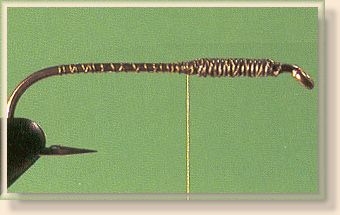
1. Place hook into vise and cover the front 1/3 of the hook shank with
lead wire substitute. Attach the tying thread and cover the wire to lock
it firmly in place. Leave the tying thread hanging at the rear of the lead
wire.
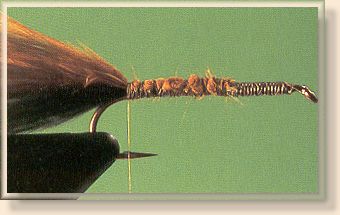
2. Strip a clump of marabou fibers from a marabou feathers. Tie in the marabou
at the rear of the lead wire. The finished tail should be about shank length.
Try mixing various colors of marabou to create a mottled effect.
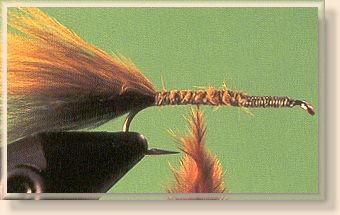
3. Pull down a 4- to 5 inch length of tying thread. Place a thin
coating of dubbing wax onto the tying thread. Place the prepared aftershaft
feathers onto the tying thread to the stem of the feather lies directly on
top of the tying thread. Lay the feathers tip to butt along the tying thread.
A size-8 fly takes about 5 aftershaft feathers.
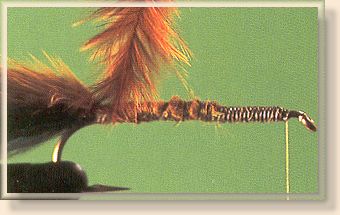
4. Bring the tying thread back up to the hook shank to form a dubbing
loop. Clost the loop at the hook shank and spin the dubbing loop tight
reinforcing the aftershaft feathers. Spin the loop until the stems of
the feathers are no longer visible and the fibers radiate out perpendicular
to the dubbing loop.
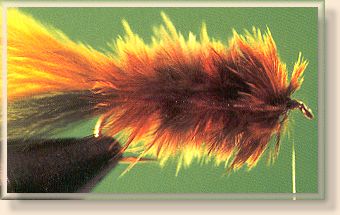
5. Wind the aftershaft dubbing loop forward to the eye to form the body.
Tie off and remove the excess aftershaft dubbing loop.
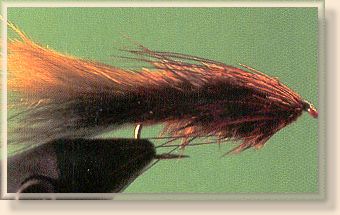
6. Prepare a pheasant rump feather by stripping the flue from the
base of the feather. Grasp the feather by the tip and sweep the
fibers downwards to expose the tip. Tie the prepared feather in by
the tip. Trim the excess material and wind the feather 2 to 3 times
around to form the hackle. Don't overdress the pattern. Tie off the
pheasant rump feather and trim the left-over material. Sweep the hackle
fibers rearward and hold in position to expse the hook eye and head
area. Build a neat neat. Whip-finish and apply head cement. Do
designate a weighted pattern place a dab of red nail polish on the
hook eye. Be careful not to close the eye of the hook accidentally
with the polish. ~ Philip Rowley
|






